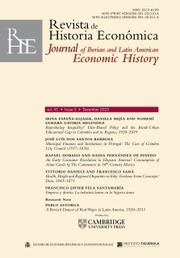Article contents
The American Empire and the Spanish Economy: an Institutional and Regional Perspective
Published online by Cambridge University Press: 28 April 2010
Extract
The Spanish Empire in America —so envied by other countries— has never been regarded by economic historians as an unmixed blessing. For Hamilton, the precious metals from the Americas caused a parallel rise in prices and wages, reducing industrial investment and thus aborting the development of capitalism. For Vilar, a critic of that view, the Empire, as «the supreme phase of feudalism», led to a primitive accumulation of capital responsible for freezing structures inhibiting to capitalism. Wallerstein recognised that America was essential for the conversion of Spain into a semi-periphery of the world market1. To that can be added other less general but equally negative approaches concerning the effects of emigration or of American treasure, seen by many as contributing to an absolutism powerful enough to impose a foreign policy alien to the interests of the country and highly damaging to the Spanish economy, and to that of Castile in particular.
- Type
- Articles-Artículos: Part 2. European Economics in the First Epoch of Imperialism and Mercantilism, 1415–1846
- Information
- Revista de Historia Economica - Journal of Iberian and Latin American Economic History , Volume 16 , Issue 1: The costs and benefits of european imperialism from the conquest of Ceuta, 1415, to the treaty of Lusaka, 1974. Twelfth International Economic History Congress. Madrid 1998 , March 1998 , pp. 123 - 156
- Copyright
- Copyright © Instituto Figuerola de Historia y Ciencias Sociales, Universidad Carlos III de Madrid 1998
References
BIBLIOGRAPHY
- 8
- Cited by




